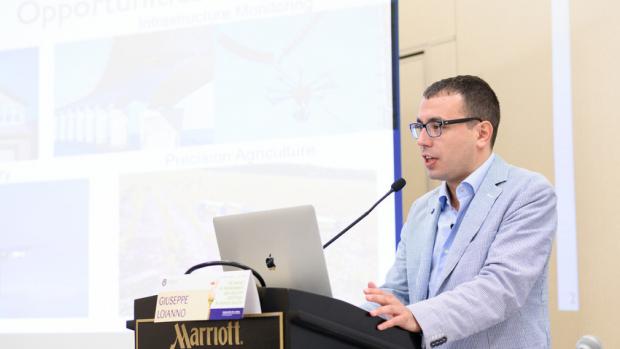NYU Tandon researcher wins NSF CAREER Award for boosting the ability of robots to navigate in challenging environments

Giuseppe Loianno
The National Science Foundation (NSF) has selected an NYU Tandon School of Engineering researcher developing novel solutions to the foundational perception-action problem in autonomous robotics to receive its most prestigious award for promising young academics.
Giuseppe Loianno — an assistant professor in the Departments of Electrical & Computer Engineering and Mechanical & Aerospace Engineering, as well as a faculty member of NYU’s Center for Urban Science and Progress (CUSP) and NYU WIRELESS — received a 2022 NSF Faculty Early Career Development Award, more widely known as a CAREER Award, which supports early-career faculty who have the potential to serve as academic role models in research and education.
A five-year, $600,000 grant will support the project “Re-Thinking the Perception-Action Paradigm for Agile Autonomous Robots.”
Small–scale aerial and ground robots with onboard sensors have the potential to help humans complete complex, hazardous tasks, including environmental monitoring, search and rescue, and supply delivery in constrained outdoor or indoor environments. They have been of great use throughout the COVID-19 crisis: handling contaminated waste, monitoring quarantine compliance, and disinfecting critical areas, for example.
Such tasks require robots capable of making fast decisions and agile maneuvers in cluttered or unpredictable environments. With greater agility, small robots could better maneuver in confined spaces as well as complete tasks quicker (a boon when battery capacity is limited).
However, small robots currently face a major challenge to their agility: their navigation systems. Because of their small size, lightweight, and limited power, they currently rely on cameras and Inertial Measurement Units (IMUs), rather than 3D sensors such as LIDAR. State-of-the-art perception and control approaches, while mature, are still far from being robust, adaptive, and resilient during agile navigation in uncertain, complex, and dynamic environments, and pushing the robot’s navigation boundaries often results in catastrophic failures.
“There’s no question that accounting for the interplay between perception — the information the robot receives from its sensors — and action — the steps it takes after — is challenging,“ Loianno says. “A fundamental problem lies in the algorithms underlying robots’ autonomous navigation, which run in a sequential manner. This increases latency and forces the robot to store a significant amount of redundant information at different layers, thereby preventing fast decision–making. These limitations require a paradigm shift if we’re committed to effectively addressing the perception-action problem for agile autonomous robots.”
Loianno is making that shift by jointly and concurrently resolving the perception-action problem; his aim is to capture the strict cross-coupling effects between perception and action and generate a new foundational theory, including models and algorithms resulting from a principled combination of perception, learning, and control. He predicts that this approach will boost autonomous inference, decision-making time, accuracy, adaptability, and robustness to various tasks and environments, all with provable performance and safety margins.
He ultimately envisions creating as part of his CAREER Award project an interactive and inclusive research and education platform he calls The Robot Code, aimed at inspiring the design, comprehension, and validation of autonomous robots; increasing understanding of their ubiquitous societal role; and advocating for their ethical use.
This platform includes a university-level core curriculum focused on perception, learning, and control for autonomous navigation, and plans are in the works for a physical racing test-bed that will not only host on-site events but will be freely remotely accessible via mmWave/5G connectivity. “Our goal is to lower the barriers to participation in research and education, especially for underrepresented groups who will be gaining access to a cutting-edge test-bed and deploying algorithms on real robots, both of which normally require substantial investments in terms of manpower and resources,” he explains. “We expect to provide a unique educational experience for students at every level, including several internship opportunities tailored for undergraduate and high-school students belonging to underrepresented minority (URM) groups in the New York area.”
His award reflects the NSF's statutory mission and has been deemed worthy of support through evaluation using the Foundation's intellectual merit and broader impacts review criteria.
See all Tandon's Career Award Winners




